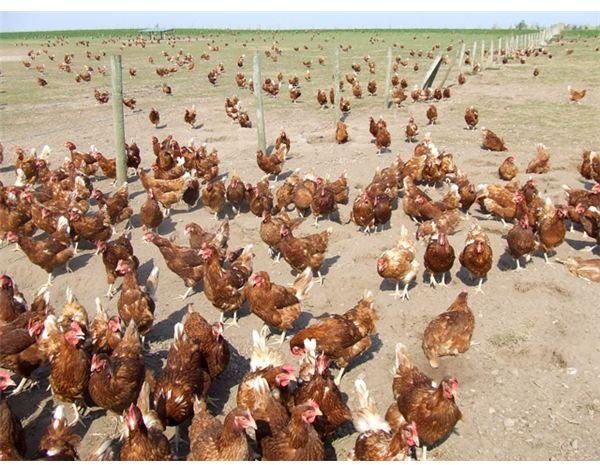Free Range Meat & Foods: Healthy and Compassionate Eating
Definition
“Free range” is a technical, legal term and it is related to compassionate livestock care. As a technical term, “free range,” as it is seen on packaging at the grocer, can mean that a door in whatever structure animals, usually poultry, are caged must be open for a specific period of time.
Free range labeling does not guarantee that animals actually roam freely. This legal technicality not only does not guarantee compassion, it is not a safeguard for organic foods. Free range does not mean organic and all that the label “organic” entails.
To find livestock that have been raised with compassion — allowed to graze openly and to raise their young in a healthy and humane manner — one must look for more than “free range” on a label. Fortunately, there are grocers that are committed to selling only compassionately-raised meats, dairy and poultry. Unfortunately, there are not many and consumers still need to be educated about what free range means.
The Problem: Factory Farms
Factory farms, which are also known as concentrated animal feeding operations (CAFOs), exist as highly mechanized operations that produce meat and other animal products at the lowest cost possible. The supposed benefit of lower costs comes at a high price, paid by the animals, consumers and the planet.
Animals are subjected to unspeakably inhumane conditions. Massive feedlots release polluting methane into the atmosphere. The close proximity of animals causes the animals to be given antibiotics to prevent infections. The long-term effects on humans of drugs and hormones in animals are unknown, but the best guesses are that the effects are dire.
Factory farm animals are fed the lowest-cost, substandard diet possible. According to the Union of Concerned Scientists, animals raised on factory farms are fed plastics, same species meat, and animal waste. Agri-business and factory farming has created a crisis and loss of family-owned farms. There is a spiritual element to all of this that cannot be calculated.
Education
Get to know the difference between what sounds good on the label and what the truth about foods produced from compassionate and truly free roaming aniamls is. First, know that the term, “free range” primarily applies to poultry and eggs. A consumer may see a carton of eggs, touted as free range, with images of idyllic farm life. Understand that this may be a marketing technique that bears no relationship to reality.
There are categories of free range as well. Chickens and eggs can be raised in free range “true,” “pastured,” or “grass-fed” conditions. If a farmer keeps chickens penned to protect them from predation and if that farmers places the penned birds in a pasture, that poultry can be labeled as “pastured.” The situation is even worse for other livestock.
Considerations
There are three basic considerations when one begins to decide what meats, if any, one will consume. The first consideration is philosophical. Consumers are removed from the grisly truths about where meat originates. The second consideration is health. What livestock eat is dangerous to the animals and holds health concerns for humans. Mad-cow Disease is an extreme example of what can happen with improper feeding.
According to a Mother Earth News article, “The Hidden Link between Factory Farms and Human Illness (February/March 2009), the ways that animals are raised presents grave danger in the second-hand antibiotics that humans consume through meat. Increased human consumption of antibiotics leads to antibiotic-resistant microbes.
The final consideration is the health of the planet. According to the same article, massive feedlots cannot handle the manure that is produced. This causes severe pollution. The Union of Concerned Scientists agrees.
Options
Once the truth about free range foods becomes clear, there are healthy options available. For committed meat-eaters, some natural foods grocers are committed to selling only meats, dairy and poultry that have been compassionately-raised. As consumers begin to buy animal products from stores that have such a commitment, the market will open up and compassionately-raised foods will be available in more grocery stores and will be more affordable.
Another option is to stop eating meat and meat products, including dairy. For some, this is an easier transition than for others. Regardless of what path one takes to cope with the issues that underlie free range foods, it is undeniable that the issue is serious with grave consequences for human beings and for the planet.
References
Sapkota, A. R., L. Y. Lefferts, S. McKenzie, and P. Walker, 2007, “They Eat What? The Reality of Feed at Animal Factories,” Union of Concerned Scientists
Sayre, Laura, Feb/March 2008, “The Hidden Link Between Factory Farms and Human Illness,” Mother Earth News
Image Credits
Wikimedia Commons/Roger Kidd/Creative Commons Attribution Share-Alike 2.0 Generic license
